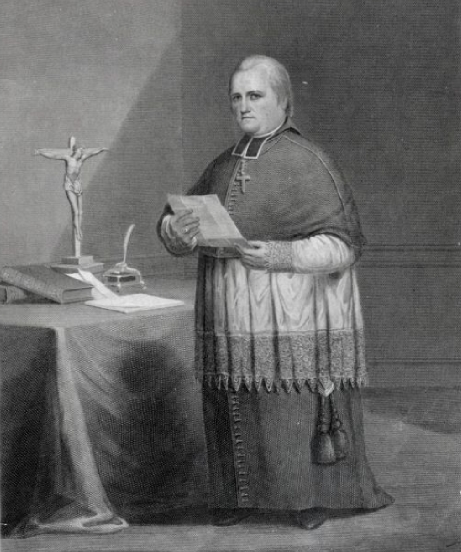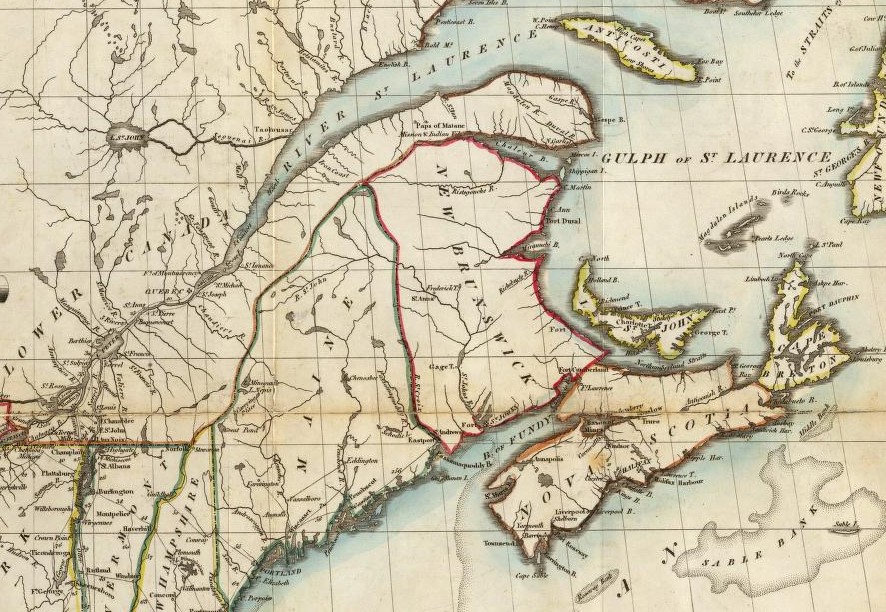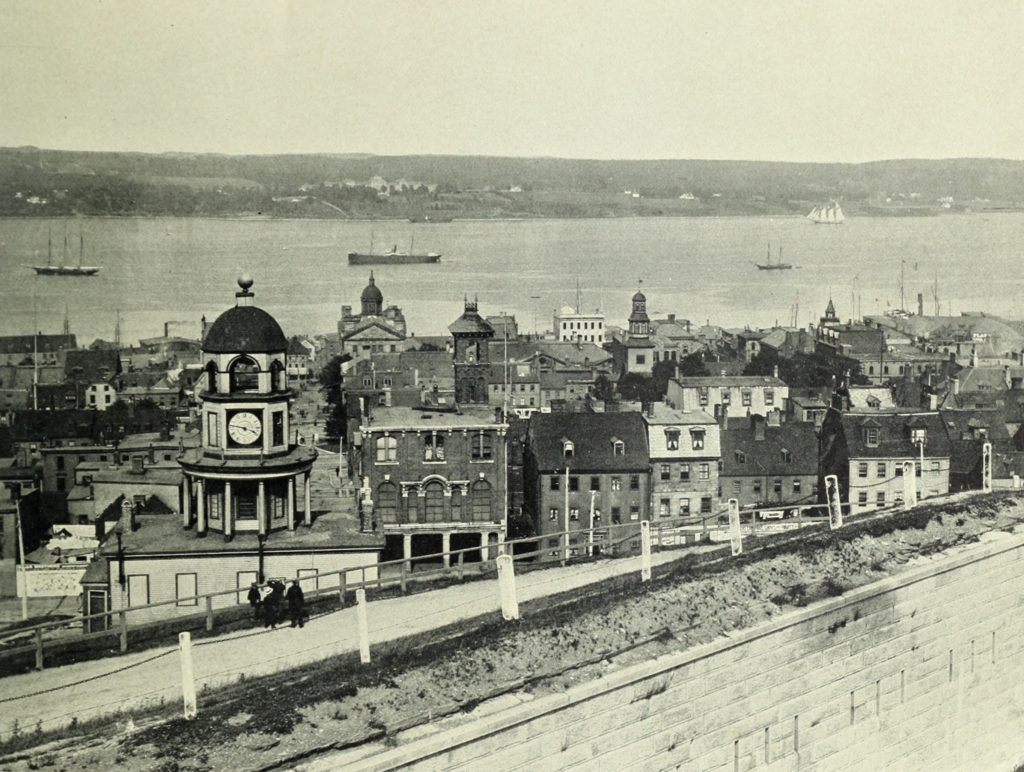Four men joined the expedition—men of the cloth, all with a strong constitution, able to carry a heavy load of personal belongings, supplies, and religious items that would eventually fill up Quebeckers’ deep well of curse words. De Boucherville, Gaulin, Gauvreau, and Bolduc had as their esteemed companion and leader the bishop of Quebec, Joseph-Octave Plessis.
The War of 1812 had postponed Plessis’s plans to visit the more easterly colonies. When news of a peace treaty crossed the Atlantic, planning for the expedition resumed. The bishop was intent on better ascertaining the conditions of Catholics in Nova Scotia and New Brunswick and bringing the sacraments to people long estranged from the Roman Catholic Church. On May 30, 1815, the five missionaries boarded La Résolution in Quebec City and eased eastward. Their progress was slow; it would take ten days to attain Cap-Chat.
Throughout the trip, Plessis and his fellow travelers encountered but also experienced the meagre conditions in which their flock lived. Near Cap-Chat, they visited a family where guests had to sit on large trunks and makeshift stools. There were only as many utensils as people living in the house, and no dish cloth—plates were simply turned over so that they might dry for the next day’s meal. There was no bread, no beer, no spices or sweets. To live in luxury might mean owning a cow.

Back on water, La Résolution passed the Magdalen Island and l’Isle Saint-Jean, today’s Prince Edward Island. Eighteen days after its departure the ship reached the western shore of Cape Breton and entered the narrow Canso “gut” that separates the island from mainland Nova Scotia. Soon the ship was dropping anchor off of the Acadian community of Arichat. The diary that Plessis kept through the voyage reflects the local enquiries he made: he identified the Arichat area as unsettled until deported Acadians returned to their homeland and formed new communities, an event that was still within living memory, if barely, when Plessis passed through.[1]
In southeastern Cape Breton, residents who fished in coastal waters had remained true to their religious duties; that could not be said of those who were hired to work in long-distance shipping. The extensive trade to which the Arichat harbor attested—not to mention the presence of Jersey merchants who respected the Catholic religion—was at least proving beneficial to these Acadians.
Arichat became Plessis’s launching pad for his various missions in the Maritime region. The Lively, the large ship that brought them around Cape Breton, seemed to promise comfort, but proved to be cramped, crawling with mice, of an incredible saline stench, and very often dark. But these conditions were not unusual when put against what Plessis encountered throughout this pastoral visit. We cannot but feel some admiration for a man who repeatedly left his episcopal palace and the amenities of Quebec City to put himself through the many discomforts and privations of travel in an era such as this.
After visiting the ruins of Louisbourg, the clergy celebrated six masses in two days for English-speaking residents of Menadou (Main-à-Dieu, facing Scatarie Island), people they found living in a state of complete destitution. In Sydney, Plessis and company found a colonial government that seemed well suited to the state of the population. (Cape Breton was then a colony separate from Nova Scotia.) The governor was not a resident; the council, which was simultaneously executive and legislative, was composed of four members whose powers were few. There was no elected house of assembly. A small garrison of 200 men guarded the harbor and, by extension, the coal fields beyond.

On June 24, jour de saint Jean-Baptiste, Plessis celebrated mass at Sydney’s impossibly tight Catholic chapel. Ten laypersons attended; none sought to confess, though they were invited to do so. Near Sydney, the clergymen lodged in a stable and offered the sacraments to Irish coal miners.[2]
At Petite Brador (Little Bras d’Or), west of Sydney, Plessis found a community that could not—by his standards—have fallen farther from the most basic articles of religion: ignorance of holy offices, mixed marriages and unions between blood relatives, drunkenness, and on. Even the venerable bishop found his hope and zeal failing. Who could he find to minister to these poor people, who had the means to neither support a priest or build a chapel? Much more than occasional missionary visitations would be needed.
After this stop the travelers were again tested by sleeping outdoors under lean-tos all the while getting soaked by unrelenting rain. Then, through the interior of Cape Breton, Plessis and his “laborers” returned to Arichat on small vessels. There they again boarded the Lively on their way to Halifax; the odor of the coal with which the hull was loaded filled the air and made the passengers ill, adding to the ordeal of sea sickness.
Plessis’s diary reveals just how taken he was with Halifax, which he reached on July 14, from its large clock and military defenses at the top of the hill to its broad streets and “great and noble buildings.” Of course, he hadn’t seen a city worthy of that name in a month and a half—and he was escaping an utterly dreadful ship. He also found a united and devoted Catholic congregation, predominantly Irish but with a sprinkling of other nationalities, and made up of all classes of society except the topmost ranks, who had to claim the Protestant faith if they were to enter political offices.

Plessis wasted no time in calling on Sir John Coape Sherbrooke, the lieutenant governor, and on the British admiral in station. The latter placed a carriage at Plessis’s disposal for his overland ventures, while Sherbrooke, when pressed by the visitor, recognized Acadians’ claim to 5000 acres of land in Chezzetcook, after struggling for years to have their legal title protected.[3] Sherbrooke and Plessis also discussed measures to improve the fate of the sixty or so Mi’kmaq families in the vicinity of Halifax, genuine concern that was molded by their own cultural blinders.[4]
In Halifax, Plessis met with the abbé Pierre-Marie Mignault, a companion for local visitations until a grave illness cut short his journey. Whereas the bishop left his mark on the Quebec church, Mignault would help to build a new transnational church whose first anchorage was to be in Burlington, Vermont—though there was little to foreshadow his accomplishments in 1815.
Mignault had grown up in Saint-Denis on the Richelieu River in Quebec; his father, a Revolutionary War veteran, was the son of Acadian deportees. In accepting a mission in Nova Scotia around the time of Plessis’s visits, Mignault was reconnecting with his grandparents’ experiences. Several years later he would return to Quebec and accept pastoral duties in Chambly. Following Plessis’s example of service to far-away flocks, from this home base he would minister to pioneer French Canadians who crossed the border. Mignault was one of the founders of the first French-Canadian national parish in the United States, established in Burlington in 1850.
Next week: Traveling with a Bishop in 1815, Part II (southern Nova Scotia to the U.S.).
[1] He would also pen a brief historical study of Louisbourg and an overview of coal extraction in the northern part of the island.
[2] They had originally only planned to visit the Catholic Mi’kmaq of Cape Breton after providing spiritual comforts to Arichat. The priests altered their itinerary as they learned of other underserved Catholic populations around the island. In many of these cases, there is little to suggest that the dispersed minority craved the attentions of a bishop.
[3] Days earlier the bishop had visited the Acadians in Forbay (possibly Tor Bay), who were originally from Chezzetcook but had been pushed out by Loyalists whose land deeds were in order. In their new settlement, the land was not arable and families had no choice but to live from fishing.
[4] Misunderstanding the ancestral way of life, Plessis had castigated the Mi’kmaq of Cape Breton—largely without a friend in the Catholic clergy for forty years—for their laziness. But his preconceived notions did not simply break along a native–settler axis; he had chosen not to stay with a poor Scottish family because of the risk of contracting some catching disease from this class of people.
Leave a Reply